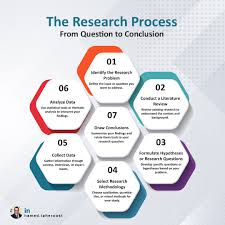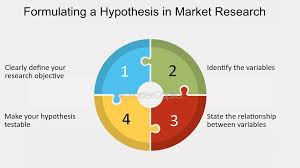Q. Discuss the steps involved in research process.
The research
process is a systematic and methodical approach to investigating a question or
problem in order to discover new knowledge or verify existing information. It
involves several key steps, each of which is crucial for ensuring the
reliability, validity, and rigor of the research findings. Research can take
many forms, from scientific experiments to social investigations or historical
inquiries, but regardless of the discipline or type of research, the process
generally follows a set of stages. These steps help guide researchers through
the complexities of gathering and analyzing data and ultimately contribute to
the development of new insights or solutions. The steps involved in the
research process are typically as follows: identifying a research problem or
question, reviewing the literature, formulating a hypothesis, designing the
research study, collecting data, analyzing data, drawing conclusions, and
communicating the findings. This process is cyclical in nature, as each step
often leads to the next, with the results and conclusions of one research
project informing future investigations.
Step 1:
Identifying a Research Problem or Question
The first step in the research process is identifying
a research problem or question. This is perhaps the most crucial stage of the
entire process, as the quality of the research problem will largely determine
the direction and success of the study. A well-defined research problem
provides focus, purpose, and direction for the study. It articulates the issue
or topic that the researcher intends to investigate and frames the problem in a
way that allows for exploration and analysis.
Researchers typically begin by identifying broad areas of interest or gaps in existing knowledge. These could be based on personal interest, societal needs, or issues arising from previous research. Once a general topic is chosen, the researcher narrows the focus to a specific problem or question that can be addressed in the research. A research problem should be clear, concise, and researchable, meaning it should be able to be tested or investigated through the collection and analysis of data.
For example, a researcher in the field of psychology
might identify the problem of how social media use affects adolescent mental
health. This broad topic could then be refined into a specific research
question such as, “How does daily use of Instagram influence self-esteem in
teenage girls?”
Step 2:
Reviewing the Literature
Once the research problem or question has been
identified, the next step is to conduct a thorough review of the existing
literature. The literature review helps researchers understand what is already
known about the topic and what gaps exist in the current body of knowledge.
This step allows the researcher to situate their study within the context of
previous work, building on existing findings and avoiding duplication of
efforts.
The literature review involves examining a wide range
of sources, such as academic journals, books, dissertations, conference papers,
and reputable online databases. Researchers analyze studies that have addressed
similar or related topics, identifying key theories, methodologies, and
findings. The literature review can also help the researcher refine the
research question, develop hypotheses, and decide on the best methods for
conducting the study.
Through this process, the researcher becomes familiar
with the key debates, trends, and limitations in the field, which in turn
guides the design and approach of their own research. Additionally, the
literature review can provide valuable insights into the theoretical frameworks
and concepts that should be used in the study.
Step 3:
Formulating a Hypothesis or Research Objectives
After reviewing the literature, the next step in the
research process is formulating a hypothesis or clearly defined research
objectives. A hypothesis is a testable prediction about the relationship
between variables in the study, often based on existing theories or prior
research findings. It provides direction and focus for the research, allowing
the researcher to design the study in a way that can either support or refute
the hypothesis.
For example, based on the research question about social media use and adolescent mental health, the researcher might hypothesize, “Increased daily use of Instagram is negatively correlated with the self-esteem of teenage girls.” This hypothesis offers a clear prediction that can be tested through data collection and analysis.
In some cases, researchers may not formulate a
specific hypothesis, especially in exploratory research or when the goal is to
understand a phenomenon rather than test a specific theory. In these cases,
researchers may establish general research objectives instead, such as
identifying patterns or relationships in the data or exploring how different
factors influence a given outcome.
Step 4:
Designing the Research Study
Once the hypothesis or research objectives have been
established, the next step is to design the research study. The research design
outlines how the study will be conducted, including the methods for data
collection, the sample population, the variables to be measured, and the tools
or instruments to be used. The research design must be carefully planned to
ensure that the study will address the research question in a valid and
reliable manner.
There are several types of research designs, each
suited to different types of research questions. Common designs include:
- Descriptive research design: Used to
describe characteristics of a population or phenomenon.
- Correlational research design: Used to
explore the relationship between two or more variables.
- Experimental research design: Used to
investigate cause-and-effect relationships by manipulating independent
variables and measuring their effect on dependent variables.
- Qualitative research design: Used to
explore complex phenomena in-depth through interviews, focus groups, or
case studies.
- Quantitative research design: Used to
collect numerical data that can be analyzed statistically.
In addition to choosing the appropriate design,
researchers must also decide on the sampling strategy, such as whether the
study will use random sampling, convenience sampling, or another method.
Sampling is critical to ensure that the study’s findings are generalizable to
the broader population.
Step 5:
Collecting Data
Data collection is a crucial part of the research
process, as it provides the raw information that will be analyzed to draw
conclusions. The data collection process involves selecting the appropriate
tools, instruments, and procedures to gather information in a systematic way.
The choice of data collection methods depends on the research design and
objectives of the study.
Common data collection methods include:
- Surveys and Questionnaires: Used to
gather self-reported data from participants.
- Interviews: Used to
obtain in-depth, qualitative data through direct interaction with
participants.
- Observations: Used to
collect data on behaviors, events, or phenomena as they occur in natural
settings.
- Experiments: Used to
manipulate variables in a controlled environment and observe the effects
on other variables.
- Archival Research: Involves
analyzing existing data or records, such as historical documents, official
reports, or datasets.
Researchers must also ensure that the data collection
process is ethical, protecting the rights and confidentiality of participants
and ensuring that data is collected in an unbiased and accurate manner. It is
important to obtain informed consent from participants and to consider any
potential risks associated with the research.
Step 6: Analyzing Data
After the data has been collected, the next step is to
analyze it. Data analysis involves organizing, cleaning, and interpreting the
data to draw meaningful conclusions that address the research question. The
methods used for data analysis depend on the type of data collected and the
research design.
For quantitative research, data analysis typically
involves statistical techniques such as descriptive statistics (e.g., mean,
median, mode), inferential statistics (e.g., t-tests, chi-square tests,
regression analysis), or multivariate analysis. These techniques allow the
researcher to test hypotheses, determine relationships between variables, and
assess the significance of the results.
For qualitative research, data analysis is often more
iterative and subjective. Researchers may use techniques such as thematic
analysis, content analysis, or grounded theory to identify patterns, themes,
and insights from interviews, focus groups, or observational data. This process
often involves coding the data, categorizing it into meaningful units, and
interpreting the underlying meaning.
Regardless of the approach, data analysis is a
critical step in the research process, as it determines the validity of the
findings and the strength of the conclusions. Researchers must be thorough and
transparent in their analysis, ensuring that the methods and results are
reproducible and reliable.
Step 7: Drawing Conclusions
Once the data has been analyzed, the next step is to
draw conclusions based on the findings. In this stage, the researcher
interprets the results and determines whether the hypothesis has been supported
or refuted. If the hypothesis is supported, the researcher may discuss the
implications of the findings and their contribution to the existing body of
knowledge. If the hypothesis is not supported, the researcher may suggest
alternative explanations or propose new questions for further research.
In addition to evaluating the hypothesis, researchers
should consider the limitations of the study, such as potential biases,
sampling issues, or external factors that could have influenced the results.
They should also consider how the findings relate to the broader context of the
field and the implications for practice, policy, or future research.
Step 8: Communicating the Findings
The final step in the research process is to
communicate the findings to others. This is typically done through the
preparation of a research report or academic paper that summarizes the study’s
objectives, methods, results, and conclusions. The research paper may be
published in an academic journal, presented at a conference, or shared with
relevant stakeholders.
The research report should be clear, concise, and
organized, with a focus on transparency and accuracy. It typically includes the
following sections: an introduction, literature review, methodology, results,
discussion, and conclusion. Additionally, researchers should provide sufficient
detail on the methods and data analysis to allow others to evaluate the
validity of the findings and replicate the study if necessary.
Conclusion
The
research process is a complex and dynamic sequence of steps that allows
researchers to investigate questions, test hypotheses, and generate new knowledge.
From identifying a research problem to communicating the findings, each step
plays a crucial role in ensuring that the research is rigorous, reliable, and
valid. The process is not always linear; researchers may need to revisit
earlier steps, refine hypotheses, or reconsider their approach based on the
findings. Nevertheless, the steps involved in the research process provide a
structured framework for conducting investigations that contribute to the
advancement of knowledge across various fields and disciplines.










0 comments:
Note: Only a member of this blog may post a comment.